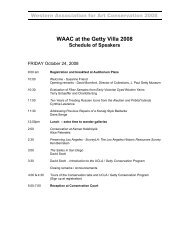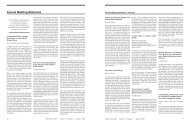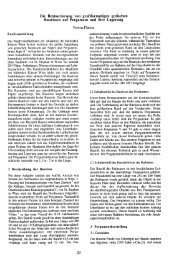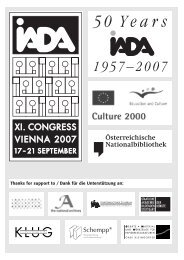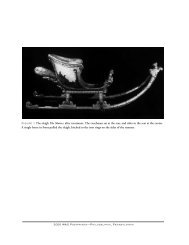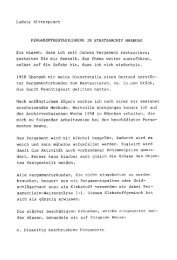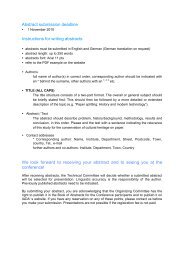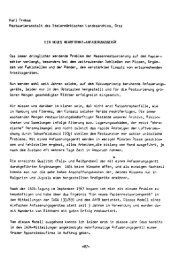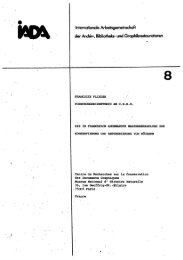Emergency Red List of Egyptian Cultural Objects at Risk - The ...
Emergency Red List of Egyptian Cultural Objects at Risk - The ...
Emergency Red List of Egyptian Cultural Objects at Risk - The ...
You also want an ePaper? Increase the reach of your titles
YUMPU automatically turns print PDFs into web optimized ePapers that Google loves.
Press release<br />
Contact<br />
R E D L I S T O F<br />
EGYPTIAN<br />
CULTURAL<br />
OBJECTS AT RISK<br />
France DESMARAIS / france.desmarais@icom.museum<br />
Tel: +33 (0)1 47 34 91 67 / Fax: +33 (0)1 43 06 78 62
1<br />
Table <strong>of</strong> contents<br />
Press release<br />
Egypt’s cultural heritage<br />
<strong>The</strong> <strong>Emergency</strong> <strong>Red</strong> <strong>List</strong><br />
<strong>of</strong> <strong>Egyptian</strong> <strong>Cultural</strong> <strong>Objects</strong> At <strong>Risk</strong><br />
Making <strong>of</strong><br />
ICOM’s fight against illicit traffic in cultural goods<br />
Intern<strong>at</strong>ional conventions<br />
N<strong>at</strong>ional and intern<strong>at</strong>ional cooper<strong>at</strong>ion<br />
ICOM’s tools in the<br />
fight against illicit traffic in cultural goods<br />
One Hundred Missing <strong>Objects</strong><br />
<strong>The</strong> Object ID Standard<br />
<strong>The</strong> <strong>Red</strong> <strong>List</strong>s<br />
<strong>The</strong> Art and <strong>Cultural</strong> Heritage Medi<strong>at</strong>ion programme<br />
<strong>The</strong> Intern<strong>at</strong>ional Council <strong>of</strong> Museums<br />
p. 2<br />
p. 4<br />
p. 5<br />
p. 7<br />
p. 9<br />
p. 12
« <strong>The</strong> <strong>Red</strong> <strong>List</strong>s help<br />
identify the types<br />
<strong>of</strong> objects th<strong>at</strong> are<br />
most sisceptible to<br />
illicit trafficking and<br />
therefore subject<br />
to smuggling and<br />
illicit trade »<br />
« This ICOM<br />
initi<strong>at</strong>ive was<br />
conducted with<br />
the particip<strong>at</strong>ion<br />
<strong>of</strong> n<strong>at</strong>ional and<br />
intern<strong>at</strong>ional<br />
experts »<br />
Press release<br />
Paris, 6 February 2012<br />
One year on from the events th<strong>at</strong> took place in Egypt in 2011, ICOM’s<br />
actions to protect the country’s cultural heritage from the ensuing thefts<br />
<strong>of</strong> non-inventoried objects from archaeological sites and museums have<br />
led to the public<strong>at</strong>ion <strong>of</strong> the <strong>Emergency</strong> <strong>Red</strong> <strong>List</strong> <strong>of</strong> <strong>Egyptian</strong> <strong>Cultural</strong><br />
<strong>Objects</strong> <strong>at</strong> <strong>Risk</strong>.<br />
ICOM publishes a new <strong>Emergency</strong> <strong>Red</strong> <strong>List</strong>: the <strong>Emergency</strong> <strong>Red</strong> <strong>List</strong> <strong>of</strong><br />
<strong>Egyptian</strong> <strong>Cultural</strong> <strong>Objects</strong> <strong>at</strong> <strong>Risk</strong><br />
<strong>The</strong> Intern<strong>at</strong>ional Council <strong>of</strong> Museums (ICOM) announces the <strong>of</strong>ficial<br />
launch, <strong>at</strong> the N<strong>at</strong>ional Museum <strong>of</strong> <strong>Egyptian</strong> Civilis<strong>at</strong>ion in Cairo (NMEC),<br />
on 6 February 2012 <strong>at</strong> 10 a.m., <strong>of</strong> a new <strong>Emergency</strong> <strong>Red</strong> <strong>List</strong>: the <strong>Emergency</strong><br />
<strong>Red</strong> <strong>List</strong> <strong>of</strong> <strong>Egyptian</strong> <strong>Cultural</strong> <strong>Objects</strong> <strong>at</strong> <strong>Risk</strong>. ICOM Director General, Julien<br />
Anfruns, <strong>of</strong>ficially presented the <strong>Emergency</strong> <strong>Red</strong> <strong>List</strong>, on this occasion, in<br />
the presence <strong>of</strong> the Director <strong>of</strong> the NMEC, Dr Mohammed Abdel F<strong>at</strong>ah.<br />
Following the present<strong>at</strong>ion, Julien Anfruns had an <strong>of</strong>ficial meeting with<br />
the Minister <strong>of</strong> St<strong>at</strong>e for Antiquities, Pr Mohammed Ibrahim Ali.<br />
<strong>The</strong> ICOM <strong>Red</strong> <strong>List</strong>s are important, effective tools designed to help police<br />
and customs <strong>of</strong>ficials, heritage pr<strong>of</strong>essionals and art and antiquities<br />
dealers identify the types <strong>of</strong> objects th<strong>at</strong> are most susceptible to illicit<br />
trafficking and therefore subject to smuggling and illicit trade. Following<br />
this important event, a seminar on illicit traffic and <strong>Red</strong> <strong>List</strong>s will take<br />
place on 7 February 2012 <strong>at</strong> 9 a.m., also <strong>at</strong> the NMEC.<br />
<strong>The</strong> <strong>Emergency</strong> <strong>Red</strong> <strong>List</strong> <strong>of</strong> <strong>Egyptian</strong> <strong>Cultural</strong> <strong>Objects</strong> <strong>at</strong> <strong>Risk</strong> was made<br />
possible thanks to the generous support <strong>of</strong> the U.S. Department <strong>of</strong> St<strong>at</strong>e’s<br />
Bureau <strong>of</strong> Educ<strong>at</strong>ional and <strong>Cultural</strong> Affairs.<br />
This ICOM initi<strong>at</strong>ive was conducted in cooper<strong>at</strong>ion with its Intern<strong>at</strong>ional<br />
Committee for Egyptology (CIPEG), and with the particip<strong>at</strong>ion <strong>of</strong> n<strong>at</strong>ional<br />
and intern<strong>at</strong>ional experts in archaeology and history and the Ministry <strong>of</strong><br />
Antiquities <strong>of</strong> the Arab Republic <strong>of</strong> Egypt. It aims to raise awareness among<br />
the local popul<strong>at</strong>ion, law enforcement <strong>of</strong>ficials and the intern<strong>at</strong>ional art<br />
and antiquities market.<br />
2
3<br />
« Any cultural<br />
object th<strong>at</strong> could<br />
have origin<strong>at</strong>ed<br />
in Egypt should<br />
be subjected to<br />
detailed scrutiny<br />
and precautionary<br />
measures »<br />
<strong>The</strong> <strong>Emergency</strong> <strong>Red</strong> <strong>List</strong> <strong>of</strong> <strong>Egyptian</strong> <strong>Cultural</strong> <strong>Objects</strong> <strong>at</strong> <strong>Risk</strong> presents<br />
c<strong>at</strong>egories <strong>of</strong> objects spanning from the Predynastic, Pharaonic and<br />
Nubian era to Greco-Roman and Coptic Egypt, as well as from the Islamic<br />
Period.<br />
<strong>The</strong> <strong>Emergency</strong> <strong>Red</strong> <strong>List</strong> aims to help art and heritage collectors,<br />
pr<strong>of</strong>essionals and customs and police <strong>of</strong>ficials identify <strong>Egyptian</strong> objects<br />
th<strong>at</strong> are protected by n<strong>at</strong>ional legisl<strong>at</strong>ion. Museums, auction houses,<br />
art dealers and collectors are encouraged not to acquire these objects<br />
without having carefully and thoroughly researched their origin and all<br />
the relevant n<strong>at</strong>ional and intern<strong>at</strong>ional legal document<strong>at</strong>ion.<br />
« This <strong>Emergency</strong> <strong>Red</strong> <strong>List</strong> will concretely assist all those, inside and<br />
outside <strong>of</strong> Egypt, concerned by an involvement in the protection <strong>of</strong><br />
<strong>Egyptian</strong> cultural heritage, by further preventing and reducing the illicit<br />
trade and export <strong>of</strong> the country’s cultural objects », Julien Anfruns said,<br />
when presenting the <strong>Egyptian</strong> <strong>Red</strong> <strong>List</strong> in Cairo.<br />
Due to the gre<strong>at</strong> diversity <strong>of</strong> objects, styles and periods, the <strong>Emergency</strong><br />
<strong>Red</strong> <strong>List</strong> <strong>of</strong> <strong>Egyptian</strong> <strong>Cultural</strong> <strong>Objects</strong> <strong>at</strong> <strong>Risk</strong> is far from exhaustive. Any<br />
cultural object th<strong>at</strong> could have origin<strong>at</strong>ed in Egypt should be subjected to<br />
detailed scrutiny and precautionary measures.<br />
<strong>The</strong> fight against illicit traffic in cultural goods requires the enhancement<br />
<strong>of</strong> both legal and practical instruments th<strong>at</strong> will dissemin<strong>at</strong>e inform<strong>at</strong>ion<br />
and raise public awareness. By launching this new <strong>Emergency</strong> <strong>Red</strong> <strong>List</strong>,<br />
ICOM is reiter<strong>at</strong>ing its firm commitment to the protection <strong>of</strong> cultural<br />
heritage, specifically in post-crisis situ<strong>at</strong>ions.<br />
This <strong>Red</strong> <strong>List</strong> was developed with the support <strong>of</strong> :<br />
U.S. Department <strong>of</strong> St<strong>at</strong>e<br />
Bureau <strong>of</strong> Educ<strong>at</strong>ional<br />
and <strong>Cultural</strong> Affairs
« Illegal<br />
excav<strong>at</strong>ions<br />
and theft have<br />
disastrous<br />
consequences for<br />
scientific research »<br />
« Since 1869, Egypt<br />
has developed the<br />
legal framework for<br />
the protection <strong>of</strong> its<br />
cultural heritage »<br />
Egypt’s cultural heritage<br />
Egypt is home to an invaluable, world-renowned, diverse cultural heritage<br />
th<strong>at</strong> stands as a living testimony to humanity’s artistic and scientific<br />
evolution. Protecting cultural goods from disappearing is <strong>of</strong> the gre<strong>at</strong>est<br />
importance and is particularly true when faced with the irreparable<br />
damage th<strong>at</strong> illicit trafficking in cultural objects can cause.<br />
Vulnerable <strong>Egyptian</strong> artefacts vary from those rel<strong>at</strong>ing to daily life to those<br />
<strong>of</strong> a religious or ceremonial n<strong>at</strong>ure. <strong>The</strong>y could have been stolen from<br />
archaeological sites and, <strong>at</strong> certain specific times, taken from institutions<br />
housing them. <strong>The</strong> most sought-after artefacts are from the Predynastic,<br />
Pharaonic and Nubian era, as well as Graeco-Roman, Coptic and Islamic<br />
periods.<br />
Egypt recognises th<strong>at</strong> the illicit excav<strong>at</strong>ion <strong>of</strong> archaeological sites and<br />
theft from collections, damages the connection between an object and<br />
its context. In turn, this prevents accur<strong>at</strong>e identific<strong>at</strong>ion and diminishes an<br />
object’s cultural and historical significance. <strong>The</strong> resulting gaps impoverish<br />
the understanding <strong>of</strong> the country’s and the world’s history.<br />
Since 1869, Egypt has developed the legal framework for the protection<br />
<strong>of</strong> its cultural heritage and multiplied efforts to counter their illegal trade.<br />
<strong>The</strong> n<strong>at</strong>ional legal tools have gre<strong>at</strong>ly evolved, thus proving the country’s<br />
unwavering commitment towards the protection <strong>of</strong> its history and the<br />
importance it bestows on conserving its heritage.<br />
Despite these efforts, Egypt’s cultural goods remain subject to illicit<br />
trafficking. <strong>The</strong>ft, looting and illegal trade and export are constant thre<strong>at</strong>s<br />
to the preserv<strong>at</strong>ion <strong>of</strong> n<strong>at</strong>ional heritage. Fighting the illicit trafficking <strong>of</strong><br />
cultural goods is everyone’s responsibility in preserving the invaluable<br />
witnesses <strong>of</strong> Egypt’s and humankind’s evolution, history and artistic<br />
expression.<br />
With the public<strong>at</strong>ion <strong>of</strong> the <strong>Emergency</strong> <strong>Red</strong> <strong>List</strong> <strong>of</strong> <strong>Egyptian</strong> <strong>Cultural</strong> <strong>Objects</strong><br />
<strong>at</strong> <strong>Risk</strong>, and its worldwide distribution to police and customs <strong>of</strong>ficers, as<br />
well as heritage pr<strong>of</strong>essionals, the Intern<strong>at</strong>ional Council <strong>of</strong> Museums<br />
(ICOM) actively contributes to intern<strong>at</strong>ional efforts in the prevention and<br />
the fight against illicit traffic in cultural goods.<br />
4
5<br />
Making <strong>of</strong><br />
« Investig<strong>at</strong>ive<br />
work led to the<br />
identific<strong>at</strong>ion <strong>of</strong><br />
perpetr<strong>at</strong>ed thefts<br />
and an assessment<br />
<strong>of</strong> the st<strong>at</strong>e <strong>of</strong> the<br />
country’s main<br />
archaeological<br />
sitesb»<br />
« <strong>The</strong> choice<br />
was made for<br />
vulnerable<br />
artefacts in the<br />
<strong>List</strong> to vary from<br />
those pertaining<br />
to daily life to<br />
those <strong>of</strong> a religious<br />
or ceremonial<br />
n<strong>at</strong>ureb»<br />
<strong>Emergency</strong> <strong>Red</strong> <strong>List</strong> <strong>of</strong> <strong>Egyptian</strong><br />
<strong>Cultural</strong> <strong>Objects</strong> <strong>at</strong> risk<br />
Following the events th<strong>at</strong> took place in Egypt on January 2011, ICOM<br />
quickly mobilised its resources in an effort to protect the country’s<br />
cultural heritage. In an emergency, obtaining reliable inform<strong>at</strong>ion is <strong>of</strong> the<br />
utmost necessity, but, in certain cases, it also presents one <strong>of</strong> the gre<strong>at</strong>est<br />
challenges. <strong>The</strong>fts <strong>of</strong> non-inventoried objects from archaeological sites and<br />
cultural heritage institutions may become widespread in the afterm<strong>at</strong>h <strong>of</strong><br />
such situ<strong>at</strong>ions, contributing to the smuggling and the illicit trading in art<br />
and antiquities.<br />
ICOM Secretari<strong>at</strong>, ICOM’s Disaster Relief Task Force (DRTF) and ICOM’s<br />
Intern<strong>at</strong>ional Committee for Egyptology (CIPEG), in cooper<strong>at</strong>ion with<br />
the Ministry <strong>of</strong> Antiquities, pooled their resources in order to analyse<br />
as accur<strong>at</strong>ely as possible the situ<strong>at</strong>ion and risks th<strong>at</strong> both the <strong>Egyptian</strong><br />
heritage and the country’s museums and sites faced.<br />
Investig<strong>at</strong>ive work led to the identific<strong>at</strong>ion <strong>of</strong> perpetr<strong>at</strong>ed thefts and<br />
an assessment <strong>of</strong> the st<strong>at</strong>e <strong>of</strong> the country’s main archaeological sites.<br />
<strong>The</strong> outcome <strong>of</strong> these monitoring efforts enabled ICOM to respond to<br />
the needs <strong>of</strong> the intern<strong>at</strong>ional community while conducting an on-site<br />
evalu<strong>at</strong>ion mission in April 2011.<br />
Following several exchanges with the <strong>Egyptian</strong> authorities, experts on<br />
the country’s heritage and members <strong>of</strong> CIPEG, ICOM Secretari<strong>at</strong> decided<br />
to launch the public<strong>at</strong>ion <strong>of</strong> a new <strong>Red</strong> <strong>List</strong>: the <strong>Emergency</strong> <strong>Red</strong> <strong>List</strong> <strong>of</strong><br />
<strong>Egyptian</strong> <strong>Cultural</strong> <strong>Objects</strong> <strong>at</strong> <strong>Risk</strong>.<br />
In order to make the <strong>List</strong> as pertinent as possible, ICOM and its experts<br />
also closely monitored and analysed the underlying trends in the <strong>Egyptian</strong><br />
objects’ black market. <strong>The</strong> choice was then made for vulnerable artefacts<br />
included in the <strong>List</strong> to vary from those pertaining to daily life to those <strong>of</strong> a<br />
religious or ceremonial n<strong>at</strong>ure.<br />
This project was developed and coordin<strong>at</strong>ed by ICOM’s Programmes<br />
Department and benefited from the close collabor<strong>at</strong>ion <strong>of</strong>: ICOM CIPEG<br />
members, Egypt’s n<strong>at</strong>ional museums, and <strong>of</strong> the Ministry <strong>of</strong> Antiquities <strong>of</strong><br />
the Arab Republic <strong>of</strong> Egypt. <strong>The</strong> <strong>Red</strong> <strong>List</strong> was made possible thanks to the<br />
generous support <strong>of</strong> the US Department <strong>of</strong> St<strong>at</strong>e’s Bureau <strong>of</strong> Educ<strong>at</strong>ional<br />
and <strong>Cultural</strong> Affairs. ICOM is also thankful for Dr. Regine Schulz, Dr. Salima<br />
Ikram and Dr. Ossama Abdel Meguid’s unwavering commitment towards<br />
the success <strong>of</strong> this project. As members <strong>of</strong> the Editorial Committee they<br />
played an essential role in the completion <strong>of</strong> the <strong>Red</strong> <strong>List</strong>.
« <strong>The</strong> <strong>Emergency</strong><br />
<strong>Red</strong> <strong>List</strong> <strong>of</strong> <strong>Egyptian</strong><br />
<strong>Cultural</strong> <strong>Objects</strong><br />
<strong>at</strong> <strong>Risk</strong> will be<br />
available in four<br />
languages »<br />
« 10,000 printed<br />
copies are being<br />
distributed around<br />
the world »<br />
« <strong>The</strong> <strong>Emergency</strong><br />
<strong>Red</strong> <strong>List</strong> <strong>of</strong> <strong>Egyptian</strong><br />
<strong>Cultural</strong> <strong>Objects</strong><br />
<strong>at</strong> <strong>Risk</strong> can be<br />
downloaded free<br />
<strong>of</strong> charge from<br />
ICOM’s website »<br />
Experts who contributed to the <strong>List</strong> are (in alphabetical order):<br />
Mohamed Abass Selim, General Director, Museum <strong>of</strong> Islamic Art in Cairo;<br />
Claire Derriks, Cur<strong>at</strong>or, <strong>Egyptian</strong> and Middle-East Collections, Musée<br />
Royal de Mariemont in Morlanwelz, Chair <strong>of</strong> ICOM CIPEG;<br />
Tarek El Awady, Director, <strong>Egyptian</strong> Museum in Cairo;<br />
Yasmin El Shazly, Head <strong>of</strong> Document<strong>at</strong>ion, <strong>Egyptian</strong> Museum in Cairo;<br />
Gawd<strong>at</strong> Gabra, visiting lecturer, School <strong>of</strong> Religion <strong>of</strong> Claremont Gradu<strong>at</strong>e<br />
University in Claremont;<br />
Salima Ikram, Pr<strong>of</strong>essor <strong>of</strong> the Egyptology and Chair SAPE, American<br />
University in Cairo, Member <strong>of</strong> ICOM CIPEG;<br />
Mary Kupelian, Lecturer, Helwan University in Cairo;<br />
Ossama Abdel Meguid, Director General, Nubian Antiquities Salvage<br />
Fund in Cairo, member <strong>of</strong> ICOM Executive Council and <strong>of</strong> ICOM CIPEG;<br />
Iris Mesko, Integr<strong>at</strong>ed expert, Museum <strong>of</strong> Islamic Art in Cairo;<br />
Ahmed Mostaf Osman, Director, Department <strong>of</strong> Rep<strong>at</strong>ri<strong>at</strong>ion <strong>of</strong> Antiquities<br />
<strong>at</strong> the Ministry <strong>of</strong> Antiquities in Cairo;<br />
Gabriele Pieke, Cur<strong>at</strong>or, Sta<strong>at</strong>liche Museen zu Berlin - Preußischer<br />
Kulturbesitz in Berlin, Secretary <strong>of</strong> ICOM CIPEG;<br />
Regine Schulz, Director and CEO, Roemer- und Pelizaeus-Museum in<br />
Hildesheim, member <strong>of</strong> ICOM Executive Council and <strong>of</strong> ICOM CIPEG;<br />
Merv<strong>at</strong> Seif El-Din, Director <strong>of</strong> scientific research, Graeco-Roman Museum<br />
in Alexandria;<br />
Abdel Ghaffar Shedid, Lecturer, Institute for Egyptology <strong>of</strong> the Ludwig-<br />
Maximilians Universität München in Munich;<br />
ICOM wishes to thank all the institutions and people who so generously<br />
provided the photographs presented in the <strong>Emergency</strong> <strong>Red</strong> <strong>List</strong> for Egypt:<br />
_Coptic Museum, Cairo<br />
_Gayer-Anderson (Beit el-Kritlaya) Museum, Cairo<br />
_Graeco-Roman Museum, Alexandria<br />
_Mummific<strong>at</strong>ion Museum, Luxor<br />
_Nubian Museum, Aswan<br />
_Roemer- und Pelizaeus-Museum, Hildesheim<br />
_Royal Museum <strong>of</strong> Art and History, Brussels<br />
_<strong>The</strong> <strong>Egyptian</strong> Museum, Cairo<br />
_<strong>The</strong> Walters Art Museum, Baltimore<br />
_Musée Royal de Mariemont, Morlanwelz<br />
_Museo Arqueologico Nacional, Madrid<br />
_Museu Nacional de Arquelogia, Lisbon<br />
_Museum <strong>of</strong> Islamic Art, Cairo<br />
<strong>The</strong> <strong>Emergency</strong> <strong>Red</strong> <strong>List</strong> <strong>of</strong> <strong>Egyptian</strong> <strong>Cultural</strong> <strong>Objects</strong> <strong>at</strong> <strong>Risk</strong> will be<br />
available in four languages. 10,000 printed copies are being distributed<br />
to police and customs <strong>of</strong>ficials from around the world, as well as heritage<br />
pr<strong>of</strong>essionals, art and antiquities dealers, and other concerned bodies.<br />
<strong>The</strong> <strong>Emergency</strong> <strong>Red</strong> <strong>List</strong> <strong>of</strong> <strong>Egyptian</strong> <strong>Cultural</strong> <strong>Objects</strong> <strong>at</strong> <strong>Risk</strong> can be<br />
downloaded free <strong>of</strong> charge from ICOM’s website, and a complete on-line<br />
d<strong>at</strong>abase dedic<strong>at</strong>ed to the <strong>Red</strong> <strong>List</strong>s can also be accessed, <strong>at</strong> the following<br />
address:<br />
http://icom.museum/wh<strong>at</strong>-we-do/resources/red-lists-d<strong>at</strong>abase.html<br />
6
7<br />
<strong>The</strong> fight against<br />
illicit traffic<br />
« <strong>The</strong> fight against<br />
illicit traffic in<br />
cultural goods is <strong>at</strong><br />
the core <strong>of</strong> ICOM’s<br />
public service<br />
mission »<br />
Conventions<br />
and cooper<strong>at</strong>ion<br />
« ICOM actively<br />
encourages the<br />
enhancement<br />
and development<br />
<strong>of</strong> appropri<strong>at</strong>e<br />
legisl<strong>at</strong>ion<br />
protecting cultural<br />
artefacts »<br />
ICOM’s fight against illicit traffic<br />
<strong>The</strong> fight against illicit traffic in cultural goods is <strong>at</strong> the core <strong>of</strong> ICOM’s<br />
public service mission and considered as one <strong>of</strong> its gre<strong>at</strong>est priority.<br />
ICOM’s actions in the field include the public<strong>at</strong>ion and dissemin<strong>at</strong>ion <strong>of</strong> a<br />
wide range <strong>of</strong> practical effective tools.<br />
Furthermore, ICOM has developed an important collabor<strong>at</strong>ive network <strong>of</strong><br />
n<strong>at</strong>ional and intern<strong>at</strong>ional experts and pr<strong>of</strong>essionals, all dedic<strong>at</strong>ed to the<br />
protection and promotion <strong>of</strong> cultural heritage. This network supports and<br />
strengthens the global fight against smuggling and illicit trading <strong>of</strong> cultural<br />
objects in various countries.<br />
IMPORTANT NOTE: ICOM wishes to underline th<strong>at</strong> n<strong>at</strong>ional authorities<br />
are the only bodies authorized to deliver permits for the export or import<br />
<strong>of</strong> cultural goods. Neither ICOM nor its intern<strong>at</strong>ional partners issue such<br />
certific<strong>at</strong>es or permissions, though documents bearing the name and logo<br />
<strong>of</strong> ICOM are regularly intercepted by police and custom’s <strong>of</strong>ficials.<br />
Intern<strong>at</strong>ional conventions<br />
As an advisor to UNESCO and UNIDROIT, ICOM took part in the<br />
development <strong>of</strong> two intern<strong>at</strong>ional conventions th<strong>at</strong> play a crucial role in<br />
protecting cultural heritage against illicit traffic:<br />
- 1970 UNESCO Convention on the Means <strong>of</strong> Prohibiting and Preventing<br />
the Illicit Import, Export and Transfer <strong>of</strong> Ownership <strong>of</strong> <strong>Cultural</strong> Property:<br />
Countries adopting the Convention commit to preventing the purchase <strong>of</strong><br />
illegally exported cultural goods, prohibiting the import <strong>of</strong> those stolen<br />
from a museum or public institution and seizing and returning stolen or<br />
illicitly imported cultural goods upon <strong>of</strong>ficial request by the country <strong>of</strong><br />
origin.<br />
- 1995 UNIDROIT Convention on Stolen or Illegally Exported <strong>Cultural</strong><br />
<strong>Objects</strong>: Places the responsibility on buyers to ensure th<strong>at</strong> the object they<br />
are acquiring has reached the market through legal means.<br />
ICOM actively encourages the r<strong>at</strong>ific<strong>at</strong>ion <strong>of</strong> these two conventions as well<br />
as the enhancement and development <strong>of</strong> appropri<strong>at</strong>e n<strong>at</strong>ional legisl<strong>at</strong>ion<br />
protecting a country’s cultural artefacts.
« ICOM is a<br />
member <strong>of</strong> the<br />
expert network<br />
<strong>of</strong> intern<strong>at</strong>ional<br />
organis<strong>at</strong>ions<br />
recognised by the<br />
United N<strong>at</strong>ions in<br />
the fight against<br />
illicit traffic in<br />
cultural goods »<br />
« ICOM works<br />
closely with<br />
several n<strong>at</strong>ional<br />
law enforcement<br />
agencies »<br />
N<strong>at</strong>ional and intern<strong>at</strong>ional cooper<strong>at</strong>ion<br />
ICOM is a member <strong>of</strong> the expert network <strong>of</strong> intern<strong>at</strong>ional organis<strong>at</strong>ions<br />
recognised by the United N<strong>at</strong>ions in the fight against illicit traffic in cultural<br />
goods; and is the only heritage body in th<strong>at</strong> group. <strong>The</strong> five other members<br />
<strong>of</strong> this network are: UNESCO, UNIDROIT, INTERPOL, WCO (World Customs<br />
Organis<strong>at</strong>ion) and UNODC (United N<strong>at</strong>ions Office on Drugs and Crime).<br />
ICOM also holds an advisory st<strong>at</strong>us <strong>at</strong> the United N<strong>at</strong>ions Economic and<br />
Social Council (ECOSOC), and works closely with several n<strong>at</strong>ional law<br />
enforcement agencies such as:<br />
- FBI Art <strong>The</strong>ft Program and the Department <strong>of</strong> Homeland Security, United<br />
St<strong>at</strong>es<br />
- Arma dei Carabinieri, Italy<br />
- Federal Office <strong>of</strong> Police (FedPol), Switzerland<br />
- Central Office for the fight against traffic in cultural goods (OCBC), France<br />
- Scotland Yard Metropolitan Police - Art and Antiquities Unit, United<br />
Kingdom<br />
- Direction <strong>of</strong> the Fight against crime against goods (DJB) <strong>of</strong> the Federal<br />
Police, Belgium<br />
In 2000, ICOM and the WCO signed an Official Cooper<strong>at</strong>ion Agreement<br />
with INTERPOL.<br />
<strong>The</strong> work <strong>of</strong> ICOM in the fight against illicit traffic benefits from the US<br />
Department <strong>of</strong> St<strong>at</strong>e and the Swiss Federal Office for Culture’s strong<br />
support, namely through its <strong>Red</strong> <strong>List</strong> programme.<br />
Reinforcing their commitment towards the protection <strong>of</strong> cultural<br />
heritage, ICOM and the World Intellectual Property Organiz<strong>at</strong>ion (WIPO)<br />
recently signed a memorandum <strong>of</strong> understanding and established the Art<br />
and <strong>Cultural</strong> Heritage Medi<strong>at</strong>ion programme. <strong>The</strong> programme proposes<br />
pr<strong>of</strong>essional medi<strong>at</strong>ion procedures for the settlement <strong>of</strong> cultural property<br />
disputes.<br />
8
9<br />
« <strong>The</strong> One<br />
Hundred Missing<br />
<strong>Objects</strong> have<br />
been successful <strong>at</strong><br />
recovering stolen<br />
objects »<br />
« <strong>The</strong> Object ID<br />
Standard is an<br />
efficient tool used<br />
to clearly describe<br />
and inventory<br />
archaeological,<br />
artistic and cultural<br />
objects in order<br />
to facilit<strong>at</strong>e their<br />
identific<strong>at</strong>ion in<br />
case <strong>of</strong> theft »<br />
ICOM’s tools in the fight against illicit traffic<br />
One Hundred Missing <strong>Objects</strong><br />
<strong>The</strong> One Hundred Missing <strong>Objects</strong> series presents cultural goods th<strong>at</strong><br />
have been stolen and whose disappearance has been reported to the<br />
police. All <strong>of</strong> the artefacts included in the public<strong>at</strong>ion are registered in the<br />
INTERPOL d<strong>at</strong>abase.<br />
<strong>The</strong> series include the following public<strong>at</strong>ions:<br />
- Looting in Angkor (1993, 2nd edition in 1997)<br />
- Looting in Africa (1994, 2nd edition in 1997)<br />
- Looting in L<strong>at</strong>in America (1997)<br />
- Looting in Europe (2001)<br />
<strong>The</strong> One Hundred Missing <strong>Objects</strong> have been successful <strong>at</strong> recovering<br />
stolen objects and can be directly credited for the return <strong>of</strong> over fifty<br />
objects.<br />
<strong>The</strong> Object ID Standard<br />
<strong>The</strong> intern<strong>at</strong>ional standard for Object Identific<strong>at</strong>ion (Object ID), launched<br />
in 1997 by the Getty Found<strong>at</strong>ion, is an efficient tool used to clearly<br />
describe and inventory archaeological, artistic and cultural objects in<br />
order to facilit<strong>at</strong>e their identific<strong>at</strong>ion in case <strong>of</strong> theft. ICOM has held the<br />
world-wide licence to transl<strong>at</strong>e, distribute and promote the use <strong>of</strong> this<br />
norm among museum pr<strong>of</strong>essionals and other concerned parties since<br />
2004.<br />
This intern<strong>at</strong>ional norm is intended to standardise the recording <strong>of</strong> an<br />
object’s d<strong>at</strong>a. Most importantly, the standard is comp<strong>at</strong>ible with the norms<br />
<strong>of</strong> INTERPOL’s d<strong>at</strong>abase, making it easier and quicker to dissemin<strong>at</strong>e the<br />
inform<strong>at</strong>ion to the world should an object be reported missing.<br />
ICOM proposes capacity building activities for museum and heritage<br />
pr<strong>of</strong>essionals, government represent<strong>at</strong>ives, as well as police and customs<br />
agents, on the use <strong>of</strong> the Object ID Standard and its function in the<br />
protection <strong>of</strong> collections.
« <strong>The</strong> number <strong>of</strong><br />
published <strong>Red</strong><br />
<strong>List</strong>s has gre<strong>at</strong>ly<br />
increased in the<br />
past two years,<br />
reflecting ICOM’s<br />
commitment<br />
towards preventing<br />
illicit traffic in<br />
cultural goods »<br />
« ICOM’s <strong>Red</strong> <strong>List</strong>s<br />
have been credited<br />
for numerous<br />
successful<br />
oper<strong>at</strong>ions by<br />
police and customs<br />
<strong>of</strong>ficials »<br />
<strong>The</strong> <strong>Red</strong> <strong>List</strong>s<br />
ICOM’s <strong>Red</strong> <strong>List</strong>s are recognised effective and practical tools th<strong>at</strong> help<br />
heritage pr<strong>of</strong>essionals, art and antiquities dealers, and most importantly,<br />
police and custom <strong>of</strong>ficials identify objects protected by n<strong>at</strong>ional<br />
legisl<strong>at</strong>ion th<strong>at</strong> may have been smuggled or illicitly traded.<br />
<strong>The</strong> number <strong>of</strong> published <strong>Red</strong> <strong>List</strong>s has gre<strong>at</strong>ly increased in the past two<br />
years, reflecting ICOM’s commitment towards preventing illicit traffic in<br />
cultural goods. ICOM has received requests for the drafting <strong>of</strong> <strong>Red</strong> <strong>List</strong>s<br />
from several countries and regions and is currently preparing several new<br />
public<strong>at</strong>ions.<br />
<strong>The</strong> <strong>Emergency</strong> <strong>Red</strong> <strong>List</strong> <strong>of</strong> <strong>Egyptian</strong> <strong>Cultural</strong> <strong>Objects</strong> <strong>at</strong> <strong>Risk</strong> is ICOM’s<br />
eleventh <strong>Red</strong> <strong>List</strong> in total, and its third <strong>Emergency</strong> <strong>Red</strong> <strong>List</strong>. Previous <strong>Red</strong><br />
<strong>List</strong> public<strong>at</strong>ions are as follows:<br />
- <strong>Red</strong> <strong>List</strong> <strong>of</strong> African Archaeological <strong>Objects</strong>, 2000<br />
- <strong>Red</strong> <strong>List</strong> <strong>of</strong> L<strong>at</strong>in-American <strong>Cultural</strong> <strong>Objects</strong> <strong>at</strong> <strong>Risk</strong>, 2003<br />
- <strong>Emergency</strong> <strong>Red</strong> <strong>List</strong> <strong>of</strong> Iraqi Antiquities <strong>at</strong> <strong>Risk</strong>, 2003<br />
- <strong>Red</strong> <strong>List</strong> <strong>of</strong> Afghanistan Antiquities <strong>at</strong> <strong>Risk</strong>, 2006<br />
- <strong>Red</strong> <strong>List</strong> <strong>of</strong> Peruvian Antiquities <strong>at</strong> <strong>Risk</strong>, 2007<br />
- <strong>Red</strong> <strong>List</strong> <strong>of</strong> Cambodian Antiquities <strong>at</strong> <strong>Risk</strong>, 2009<br />
- <strong>Red</strong> <strong>List</strong> <strong>of</strong> Endangered <strong>Cultural</strong> <strong>Objects</strong> <strong>of</strong> Central America and Mexico,<br />
2009<br />
- <strong>Emergency</strong> <strong>Red</strong> <strong>List</strong> <strong>of</strong> Haitian <strong>Cultural</strong> <strong>Objects</strong> <strong>at</strong> <strong>Risk</strong>, 2010<br />
- <strong>Red</strong> <strong>List</strong> <strong>of</strong> Chinese <strong>Cultural</strong> <strong>Objects</strong> <strong>at</strong> <strong>Risk</strong>, 2010<br />
- <strong>Red</strong> <strong>List</strong> <strong>of</strong> Colombian <strong>Cultural</strong> <strong>Objects</strong> <strong>at</strong> <strong>Risk</strong>, 2010<br />
ICOM is <strong>at</strong> the moment drafting the <strong>Red</strong> <strong>List</strong> <strong>of</strong> Dominican <strong>Cultural</strong> <strong>Objects</strong><br />
<strong>at</strong> <strong>Risk</strong> and the <strong>Red</strong> <strong>List</strong> <strong>of</strong> West African <strong>Cultural</strong> <strong>Objects</strong> <strong>at</strong> <strong>Risk</strong>.<br />
<strong>Red</strong> <strong>List</strong>s success stories<br />
ICOM’s <strong>Red</strong> <strong>List</strong>s have been credited for numerous successful oper<strong>at</strong>ions<br />
by police and customs <strong>of</strong>ficials in identifying and seizing cultural goods,<br />
the following are but a few chosen examples:<br />
<strong>The</strong> N<strong>at</strong>ional Museum <strong>of</strong> Afghanistan recognises th<strong>at</strong> the <strong>Red</strong> <strong>List</strong> <strong>of</strong><br />
Afghanistan Antiquities <strong>at</strong> <strong>Risk</strong> allowed for the return <strong>of</strong> 8,000 objects<br />
from all over the world in the past four years. Specifically, between 2007<br />
and 2009, and thanks to the <strong>Red</strong> <strong>List</strong>, English customs <strong>of</strong>ficials <strong>at</strong> He<strong>at</strong>hrow<br />
Airport were able to intercept, confisc<strong>at</strong>e and return 3.4 tons <strong>of</strong> stolen<br />
objects, representing over 1,500 items.<br />
In 2008, thanks to the <strong>Emergency</strong> <strong>Red</strong> <strong>List</strong> <strong>of</strong> Iraqi Antiquities <strong>at</strong> <strong>Risk</strong>, a<br />
cuneiform tablet was identified on the Swiss eBay website. <strong>The</strong> Swiss<br />
authorities were informed and e-Bay was able to stop the auction just<br />
before the sale was concluded.<br />
10
11<br />
« <strong>The</strong> ICOM-<br />
WIPO Medi<strong>at</strong>ion<br />
procedure is open<br />
to all, including<br />
non-ICOM<br />
members »<br />
On March 2006, the <strong>Red</strong> <strong>List</strong> <strong>of</strong> African Archaeological <strong>Objects</strong> allowed for<br />
the return <strong>of</strong> over 6,000 artefacts stolen from archaeological sites in Niger<br />
and seized by French customs’ <strong>of</strong>ficials in 2004 and 2005.<br />
Also in 2006, French customs’ <strong>of</strong>ficials seized cr<strong>at</strong>es from Togo containing<br />
Nigerian artefacts. One <strong>of</strong> them was revealed to be a genuine Nok<br />
st<strong>at</strong>uette.<br />
On January <strong>of</strong> th<strong>at</strong> same year, an Iraqi found<strong>at</strong>ion nail was identified during<br />
an auction in Paris, thanks to the <strong>Emergency</strong> <strong>Red</strong> <strong>List</strong> <strong>of</strong> Iraqi Antiquities<br />
<strong>at</strong> <strong>Risk</strong>. An investig<strong>at</strong>ion was launched by the police department <strong>of</strong> Paris<br />
after the Iraqi permanent deleg<strong>at</strong>ion <strong>at</strong> UNESCO made a formal request.<br />
Art and <strong>Cultural</strong> Heritage Medi<strong>at</strong>ion programme<br />
<strong>The</strong> current increase in ownership disputes and restitution claims<br />
requires finding solutions other than litig<strong>at</strong>ion. ICOM’s dedic<strong>at</strong>ion to the<br />
fight against illicit traffic in cultural goods has led it to act in the process<br />
<strong>of</strong> return <strong>of</strong> cultural assets, becoming highly involved in promoting the<br />
restitution <strong>of</strong> illicitly acquired cultural property. ICOM had demonstr<strong>at</strong>ed<br />
its skills in this issue with the successful don<strong>at</strong>ion <strong>of</strong> the Makondé Mask<br />
to Tanzania by the Barbier-Mueller Museum on May 2010.<br />
<strong>The</strong> Art and <strong>Cultural</strong> Heritage Medi<strong>at</strong>ion programme was launched as the<br />
result <strong>of</strong> cooper<strong>at</strong>ion between ICOM and WIPO. This fruitful collabor<strong>at</strong>ion<br />
resulted in the signing <strong>of</strong> a Memorandum <strong>of</strong> Understanding and <strong>of</strong>ficial<br />
launch <strong>of</strong> the Medi<strong>at</strong>ion programme in May 2011.<br />
Medi<strong>at</strong>ion is a voluntary procedure designed to s<strong>at</strong>isfy the long felt<br />
need for a specialized altern<strong>at</strong>ive dispute resolution. <strong>The</strong> ICOM-WIPO<br />
Medi<strong>at</strong>ion procedure is open to all, including non-ICOM members. Those<br />
who request medi<strong>at</strong>ion from the ICOM-WIPO Medi<strong>at</strong>ion rules benefit<br />
from the special joint <strong>List</strong> <strong>of</strong> Medi<strong>at</strong>ors selected for their skills and their<br />
medi<strong>at</strong>ion expertise in the art and cultural heritage field.<br />
Medi<strong>at</strong>ion has several distinctive characteristics and advantages, and is<br />
able to overcome the st<strong>at</strong>ute <strong>of</strong> limit<strong>at</strong>ions. It takes into account customary<br />
laws for claims such as misuse <strong>of</strong> traditional cultural expressions.<br />
Medi<strong>at</strong>ion under the ICOM-WIPO Medi<strong>at</strong>ion rules is a guarantee <strong>of</strong> respect<br />
for impartiality and independence and <strong>of</strong> the high ethical standards<br />
embodied in the ICOM Code <strong>of</strong> Ethics for Museums. <strong>The</strong> programme<br />
responds to the needs <strong>of</strong> the world museum community and complements<br />
ICOM’s actions in the area <strong>of</strong> illicit traffic, <strong>of</strong>fering an accessible solution.
« ICOM is<br />
committed to<br />
promoting and<br />
protecting the<br />
world’s n<strong>at</strong>ural and<br />
cultural heritage,<br />
present and future,<br />
tangible and<br />
intangible »<br />
<strong>The</strong> Intern<strong>at</strong>ional Council <strong>of</strong> Museums<br />
<strong>The</strong> Intern<strong>at</strong>ional Council <strong>of</strong> Museums (ICOM) is the main intern<strong>at</strong>ional<br />
organis<strong>at</strong>ion <strong>of</strong> museums and museum pr<strong>of</strong>essionals committed to<br />
promoting and protecting the world’s n<strong>at</strong>ural and cultural heritage,<br />
present and future, tangible and intangible.<br />
With almost 30,000 members in 137 countries, ICOM is an intern<strong>at</strong>ional<br />
pr<strong>of</strong>essional organis<strong>at</strong>ion active in a wide range <strong>of</strong> museological and<br />
heritage-rel<strong>at</strong>ed disciplines. Through its numerous concrete programmes,<br />
ICOM is among the few global organis<strong>at</strong>ions th<strong>at</strong> are able to quickly and<br />
efficiently mobilise experts in cultural heritage worldwide.<br />
Cre<strong>at</strong>ed in 1946, ICOM maintains formal rel<strong>at</strong>ions with UNESCO and has a<br />
consult<strong>at</strong>ive st<strong>at</strong>us with the United N<strong>at</strong>ions Economic and Social Council.<br />
ICOM maintains <strong>at</strong> the core <strong>of</strong> its public service missions the fight against<br />
illicit traffic in cultural goods and emergency preparedness and response<br />
for museums in case <strong>of</strong> n<strong>at</strong>ural or human-made disasters.<br />
With its Code <strong>of</strong> Ethics, ICOM has cre<strong>at</strong>ed a reference tool th<strong>at</strong> sets<br />
standards <strong>of</strong> excellence to which all institutions in the organis<strong>at</strong>ion<br />
must adhere to. <strong>The</strong> ICOM Code <strong>of</strong> Ethics for Museums, transl<strong>at</strong>ed into<br />
36 languages, establishes values and principles shared by ICOM and the<br />
intern<strong>at</strong>ional museum community. <strong>The</strong>se standards evolve in accordance<br />
with the changing world in which museums exist.<br />
Supporting the fight against illicit traffic in cultural goods is among ICOM’s<br />
highest priorities. <strong>The</strong> <strong>Red</strong> <strong>List</strong>s have been designed to raise awareness on<br />
the smuggling and illicit trade <strong>of</strong> cultural objects from certain countries<br />
or regions <strong>of</strong> the world, thus aiding in protecting these countries’ cultural<br />
and historical heritage.<br />
For any m<strong>at</strong>ter regarding ICOM or for an interview with M. Julien Anfruns, Director<br />
General <strong>of</strong> ICOM, please contact:<br />
Aurélie AUBOURG: aurelie.aubourg@icom.museum / Tel: +33 (0)1 47 34 91 63<br />
12



